|
|
|
 |
 |
 |
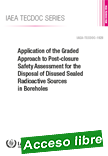 |
Application of the Graded Approach to Post-closure Safety Assessment for the Disposal of Disused Sealed Radioactive Sources in Boreholes
IAEA TECDOC No. 1928
English IAEA-TECDOC-1928 ¦ 158 pages ¦ Date published: 2020
Sealed radioactive sources are used all over the world for beneficial purposes in areas including medicine, industry, research and agriculture. These sources are usually managed safely and securely while in use. However, after they become disused, sealed sources remain hazardous and must continue to be managed safely and securely.
|
For sources that cannot be re-purposed or recycled, disposal provides the only permanent, safe, secure and sustainable management solution. A fundamental principle is that safety has to be assessed consistent with a graded approach. This ensures that the level of effort applied in carrying out safety assessment is commensurate with the magnitude of the risks from the facility or activity. In accordance with the relevant IAEA safety standards, this publication describes how the graded approach can be applied to post-closure safety assessment for the disposal of disused sealed radioactive sources in boreholes. It is intended primarily for those involved in developing or regulating borehole disposal facilities for disused sealed radioactive sources.
|
 |
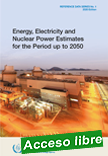 |
Energy, Electricity and Nuclear Power Estimates for the Period up to 2050 - 2020 Edition
Reference Data Series No. 1
English IAEA-RDS-1/40 ¦ 137 pages ¦ Date published: 2020
The 40th edition of RDS-1 contains estimates of energy, electricity and nuclear power trends up to the year 2050. The publication is organized into world and regional subsections, with global and regional nuclear power projections presented as low and high cases, encompassing the uncertainties inherent in projecting trends.
|
.-
|
 |
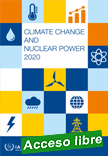 |
Climate Change and Nuclear Power 2020
English ¦ STI/PUB/1911 ¦ ISBN 978-92-0-115020-2 ¦ 97 pages ¦ Date published: 2020
This publication provides an update on the current status of nuclear power and prospects for its contribution, together with other low carbon energy sources, to ambitious mitigation strategies that will help the world limit global warming to 1.5°C in line with the 2016 Paris Agreement. Since 2000, the IAEA has issued such information and analysis regularly, in order to support those Member States that choose to include nuclear power in their energy system as well as those considering other strategies.
|
The focus of the 2020 publication is on the significant potential of nuclear energy, integrated in a low carbon energy system, to contribute to the 1.5°C climate change mitigation target, and the challenges of realizing this potential. Energy system and market related factors affecting the transition to a low carbon energy system are reviewed. This edition also outlines developments needed to realize the large scale capacity increase required to rapidly decarbonize the global energy system in line with limiting global warming to 1.5°C.
|
 |
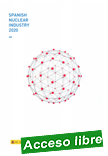 |
Spanish Nuclear Industry Catalogue (2020)
.
This catalogue, updated in July 2020, presents the Spanish Nuclear Industry, with the objective of reflecting the reality of this open and dynamic sector in a growing international market.
|
.
|
 |
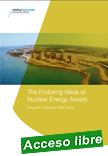 |
The Enduring Value of Nuclear Energy Assets - Long-term Operation Task Force
World Nuclear Association, June 2020. 12 p.
This World Nuclear Association technical position describes the benefits of long-term operation (LTO) of nuclear power plants, and the main considerations that need to be taken into account to ensure the longevity of nuclear operations in the years ahead. LTO of nuclear power plants (i.e. operation beyond their original licence period or expected period of operation) allows these plants to generate reliable, lowcost, low-emission electricity for many years longer than originally envisioned and thus maximise their value.
|
LTO has been successfully demonstrated and is now standard practice. While not all reactors will achieve longevity, most of the world’s currently operating fleet of nuclear power reactors are technically capable of doing so. In fact, the majority of recent nuclear plant closures are attributable to worsening market conditions or else governmental decree, rather than to ageing-related issues. It is becoming increasingly obvious that LTO of nuclear plants reduces energy costs and helps to protect the environment as part of a clean and resilient energy strategy. In most markets, LTO is the lowest-cost option for generating electricity, and is expected to stay that way for decades to come. With climate change now an urgent global issue, countries cannot afford to retire reliable, low-carbon energy generators that support the entire electricity system.
|
 |
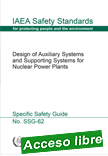 |
Design of Auxiliary Systems and Supporting Systems for Nuclear Power Plants
Specific Safety Guide
IAEA Safety Standards Series No. SSG-62 ¦ English ¦ STI/PUB/1885 ¦ 78 pages ¦ Date published: 2020
There is a general agreement that auxiliary and supporting systems play an important role in the safe operation of a nuclear power plant. There is, however, no clear definition of such systems. The purpose of this publication is to propose a stepwise definition of auxiliary systems and supporting systems for nuclear power plants with water cooled reactors,
|
describe the general design concepts and design recommendations that are common to these systems, as well as to provide recommendations on specific design considerations for a selection of auxiliary and supporting systems.
|
 |
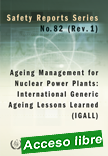 |
Ageing Management for Nuclear Power Plants: International Generic Ageing Lessons Learned (IGALL)
Safety Reports Series No. 82 (Rev. 1) ¦ English ¦ STI/PUB/1895 ¦ 110 pages ¦ Date published: 2020
This Safety Report provides detailed information on ageing management programmes and time limited ageing analyses to manage existing and potential ageing effects and degradation mechanisms of structures, systems and components (SSCs) that are important to the safety of nuclear power plants. It has been written to assist operating organizations and regulatory bodies by specifying a technical basis and providing practical guidance on managing ageing of mechanical, electrical and instrumentation and control components, and civil structures.
|
It also provides a common, internationally recognized basis on what constitutes an effective ageing management programme, a knowledge base on ageing management for design of new plants and design reviews, and a roadmap to available information on ageing management.
|
 |
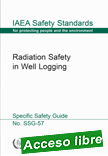 |
Radiation Safety in Well Logging
IAEA Safety Standards Series No. SSG-57 ¦ English ¦ STI/PUB/1879 ¦ 95 pages ¦ Date published: 2020
This Safety Guide provides recommendations on the use of radioactive sources and radiation generators in well logging, including in the manufacture, calibration and maintenance of well logging tools. It provides recommendations on radiation protection and safety for the storage, use and transport of such radiation sources.
|
The guidance in this publication is aimed primarily at operating organizations that are authorized to undertake well logging with radiation sources, as well as their employees and radiation protection officers. The guidance will also be of interest to regulatory bodies, and to designers, manufacturers, suppliers, and maintenance and servicing organizations of well logging equipment that contains radiation sources.
|
 |
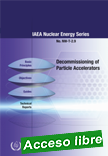 |
Decommissioning of Particle Accelerators
IAEA Nuclear Energy Series NW-T-2.9
English ¦ STI/PUB/1854 ¦ ISBN: 978-92-0-102419-0 ¦ 160 pages ¦ Date published: 2020
This publication presents information on experience and lessons learned from implementation of decommissioning projects for particle accelerators. Based on this information, and highlighting typical issues and concerns, the publication provides practical guidance for all those having a role in this process.
|
The publication is written for operators of accelerator facilities, particularly those facilities approaching the decommissioning stage, or operators maintaining a facility in a deferred dismantling state, as well as for regulators, waste managers, decision makers at government level, local authorities, decommissioning contractors and designers of accelerators. It is anticipated that lessons learned and described in this publication will contribute to decommissioning planning during the design stage of new facilities, hence minimizing the generation of radioactive waste without compromising structural characteristics and the effectiveness of the construction.
|
 |
 |
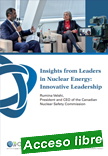 |
Insights from Leaders in Nuclear Energy: Innovative Leadership
English, published: 05/29/20
Insights from Leaders in Nuclear Energy shares personal insights through a series of in-depth conversations between the OECD Nuclear Energy Agency Director-General and leading figures in the sector. Each conversation explores the current issues and offers new ways to address challenges and aim for excellence.
William D. Magwood IV, Director-General of the Nuclear Energy Agency (NEA), sat down with Rumina Velshi, President and Chief Executive Officer of the Canadian Nuclear Safety Commission, on 17 January 2020.
|
Ms Velshi has extensive experience in the energy sector, including its technical, regulatory and adjudicatory aspects. She visited the NEA to attend briefings on key programmes and activities and to have an open discussion on issues related to leadership in today’s nuclear energy sector. In a wide-ranging discussion, she shared her perspectives as a leader in nuclear safety, her long-standing involvement in nuclear energy regulation and her activities promoting careers in science, technology, engineering and mathematics (STEM). The conversation covered the important aspects of leadership, current issues affecting an organisation that promotes nuclear safety, preparation for future nuclear energy technologies and the achievement of a better gender balance in the workforce.
|

|
|
|
| |
|
|
| |
| |
|
|
| |
| |
|
|
| |
| |
|
|
|
| |
| |
|
|
|
|
